Through the programme, Finnish farmers are entitled to apply for natural handicap payments intended to compensate for impediments to farming caused by the country’s northern conditions. Such payments maintain operational preconditions of farming, ensuring that agricultural land continues to be used for agricultural purposes.
Although the number of farms is in steady decline, the acreage of land used for food production has remained unchanged. Farmers also have the opportunity to apply for compensation for extra costs attributable to organic production and for the adoption of more environmentally friendly methods. By the end of 2014, the opportunity of obtaining environmental payments had been applied to 95% or the agricultural land. The acreage under organic production has increased during the programme period.
In 2013, support for organic production was paid for 185,000 hectares, which is almost as much as the target set in the Rural Development Programme. The Rural Development Programme seeks to enhance the competitiveness of farms, modernise food production and promote sustainable farming methods. The most recent information has been provided at meetings attended by more than 42,000 people. Training has been provided to improve business skills and raise the environmental consciousness of
farmers and other entrepreneurs.
Demand for versatile training exists because one-third of Finnish farms and horticultural enterprises have expanded their operations beyond agriculture and horticulture to activities often involving new services such as tourism or contracting using heavy equipment. Diversification is most common in cities and adjacent areas, as well as in sparsely populated areas. In Lapland and Uusimaa, nearly two-thirds of farms have moved into several different lines of business. Other businesses employ 9,100 salaried workers.
In order to improve productivity, the programme supports the development of farm structures. This refers to support aimed at speeding up farms’ renewal processes and growth as well as the acquisition of technology and at helping young farmers get started. In the course of the programme, 3,000 young farmers received support during the early phases of their entrepreneurial activity, and 1,800 farms obtained investment subsidies from the European Agricultural Fund for Rural Development. Farms that developed their activities through investments were larger in size than the average. For example, farms that received support to build a cowshed had 79 stalls for cows on average after the implementation of the investments, compared with the average 33 stalls.

Two success stories: circulation of nutrients and animal welfare
Intensified utilisation of nutrients can be regarded as one of the most remarkable achievements of the environmental work carried out in agriculture. The amount of extra nitrogen and phosphorus that remains in the soil has decreased substantially since 1990: The nitrogen balance has decreased by 50% and the phosphorus balance by 86%. However, the differences between regions are substantial, and a great deal of work remains to be done on nutrient circulation in areas with intensive livestock farming.
Opportunities offered for enhancing animal welfare have also grown in popularity. In 2013, 41% of Finnish cattle farms and 76% of pig farms received subsidies for investing in animal welfare. The reduction in the number of livestock farms has increased the number of farms that commit themselves to animal welfare; in other words, those farms that remain in business are willing to respond to the demand from the market and consumers’ values.

